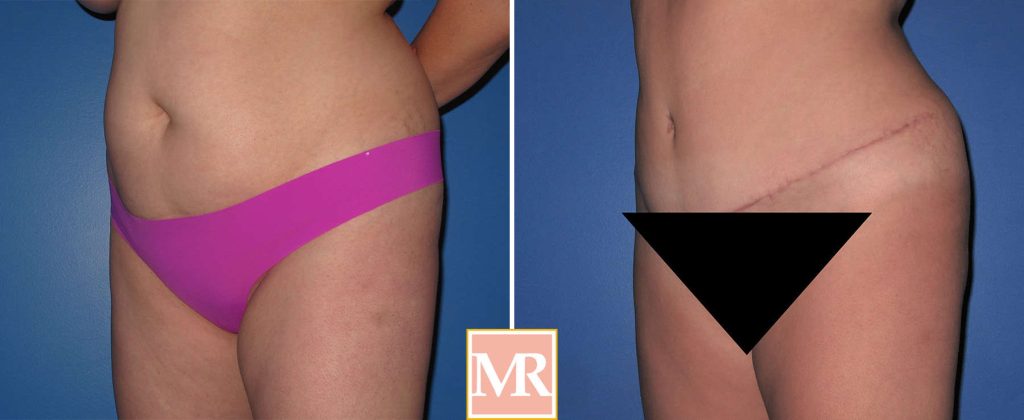Curious about how tummy tuck scars look after 5 years?
Generally, they become much less noticeable, blending with your natural skin tone.
Although they won’t completely disappear, you can expect significant fading.
This guide will walk you through what to expect and how to manage your scars effectively over the years.
Topic Overview
- Tummy tuck scars generally become less noticeable over five years, blending more with surrounding skin, but complete disappearance is unlikely.
- Factors such as genetics, sun exposure, and post-operative care significantly influence scar appearance, making effective management techniques essential.
- Various advanced treatments, including silicone sheets, laser therapy, and surgical revision, can improve the appearance of persistent and raised scars.

Book Your Appointment
With Dr. Rovelo, a top plastic surgeon in Beverly Hills
Tummy Tuck Scars After 5 Years: What to Expect
After 5 years, tummy tuck scars typically blend closely with the surrounding skin tone, becoming less noticeable and easier to conceal beneath clothing.
While most tummy tuck scars won’t completely disappear, they generally become minimal in visibility.
At this stage, scars heal and are fully mature and stable, which often leads to better acceptance and an improved body image.
How Tummy Tuck Scars Change Over Time
Immediately after tummy tuck surgery, scars are swollen, red, and slightly raised.
Within the first 6 months, as the blood supply decreases, the appearance of these scars begins to fade, transitioning to a flatter and lighter state by the end of the year.
By the one to two-year mark, tummy tuck scars typically reach full maturity.
They become smoother, blend better with the surrounding skin, and their appearance continues to improve over time.
These scars may continue to fade over 5 years, though individuals with darker scars might experience more persistent discoloration.
Long-term changes in tummy tuck scars depend on the body’s natural healing process and adherence to effective scar management techniques.
Factors Influencing Scar Appearance
Several factors influence how tummy tuck scars appear after five years, including genetics, sun exposure, a bad tummy tuck, and post-operative care.
Certain skin types, particularly those prone to thicker scarring, may experience more prominent scars.
Inconsistent post-op care can also result in hypertrophic or keloid scarring, making scars raised or darker.
Sun exposure is another factor can cause discoloration and thicken scars over time.
Additionally, the depth of the incision and how it is hidden can affect the amount of scarring.
Therefore, protecting scars from the sun and following a surgeon’s care instructions are vital for minimizing their visibility.
Types of Tummy Tuck Scars
Understanding the types of tummy tuck scars can help you better manage expectations and care for them accordingly.
Tummy tuck scars can be classified into three main types: full, mini, and extended.
The appearance of these visible scars varies significantly based on the technique used and the extent of the procedure, affecting scars appearance.
Full Tummy Tuck Scars
Full tummy tuck scars typically include a horizontal scar across the lower abdomen.
These abdominoplasty scars are generally located below the bikini line, making them easier to conceal.
The belly button incision scar fades into the belly button and is less visible, contributing to a more aesthetically pleasing result.
Mini Tummy Tuck Scars
Mini tummy tuck scars are usually shorter and less noticeable compared to those from a full tummy tuck.
They are typically located in a similar position below the bikini line, but they are not as long as a full tummy tuck scar.
Traditionally, there is not a belly button scar, either.
Extended Tummy Tuck Scars
Scars from an extended tummy tuck can extend across the abdomen and around the hips, creating a longer incision than a mini or full tummy tuck scar.
Despite their length, these scars can often be hidden under clothing, including swimsuits, making them less of a concern for many patients.
Book an appointment today with Dr. Rovelo
Effective Scar Management Techniques
Proper scar management techniques can significantly improve the appearance of tummy tuck scars.
Consistent aftercare, including proper care, moisturizing, and sun protection, is essential for enhancing scar appearance while removing excess skin.
Various products and treatments, such as silicone sheets, laser therapy, and topical treatments, offer effective solutions for managing tummy tuck scars.
Silicone Sheets and Gels
Silicone products, like silicone gel sheets or silicone gel, can flatten and reduce the appearance of scars over time.
These products help manage tummy tuck scars by creating a barrier that hydrates the skin and promotes better healing.
Silicone treatment can begin once the incisions are fully healed, typically within the first few weeks of surgery.
Your surgeon is the best person to determine when your scars are ready to begin treatment.
Silicone scar treatment should continue for at least 3-6 months.
Laser Treatments
Laser treatments significantly improve the texture and pigmentation of scars.
There are various lasers designed to address scarring.
Some lasers are designed to reduce the red pigment of scars and are best used early in the post-operative course.
Others are designed to be used later and address thickened or irregular scarring.
A treatment course usually requires 4-6 sessions spaced 4-6 weeks apart.
Always discuss these options with your surgeon prior to seeking treatment.
Microneedling
Microneedling for scars is used to improve the texture of a scar.
It is helpful for scars that have a slightly irregular texture.
It helps to remodel the scar and allows it to blend in more easily with normal surrounding skin.
It should not be used for hypertrophic or keloid scars.
Treatment can be initiated anytime after 3 months.
A treatment course usually requires 4-6 sessions spaced 4-6 weeks apart.
Post-Surgery Care for Optimal Healing
Post-surgery tummy tuck care is crucial for optimal healing and minimizing the appearance of tummy tuck scars.
Adhering to post-operative care instructions, protecting scars from sun exposure, and maintaining a healthy lifestyle are key to achieving the best scar outcomes.
Following Surgeon’s Instructions
Adhering to a surgeon’s instructions is critical to ensure proper healing and minimize the appearance of scars.
In the initial weeks after surgery, it is essential to keep the incision clean, avoid unnecessary movement, and possibly receive steroid injections.
Protecting Scars From Sun Exposure
Protecting scars from sun exposure is crucial to prevent them from darkening and becoming more noticeable.
This protection is most critical in the first 3-6 months after surgery.
Applying broad-spectrum sunscreen with SPF 30 or higher protects against UVA and UVB rays, preventing scar discoloration.
Keeping them covered when exposed to the sun is also very important.
Maintaining a Healthy Lifestyle
Maintaining a healthy lifestyle plays a crucial role in promoting better scar healing.
Proper nutrition, hydration, and stable weight are essential for healing and improving scar appearance.
Rapid weight gain or weight loss in the early scar maturation phase can result in scars stretching out or becoming irregular in texture.
Advanced Solutions for Persistent Scarring

For persistent scarring, advanced treatments such as laser resurfacing, steroid injections, and surgical revision are available.
These treatments can provide significant improvements in the appearance of stubborn tummy tuck scars.
Steroid Injections
Steroid injections effectively reduce the size and visibility of raised or hypertrophic scars.
These injections specifically target hypertrophic scars, helping to flatten and improve their appearance.
Surgical Revision
Surgical revision aims to improve the appearance of significant scars that have not responded to other treatments.
It involves removing the existing scar and possibly repositioning the incision to enhance healing through scar revision surgery.
Psychological Impact and Patient Satisfaction
The psychological impact of tummy tuck scars can vary, but many patients report overwhelming satisfaction with their surgery results despite the presence of scars.
Understanding scar formation and setting realistic expectations are crucial for managing emotions and overall satisfaction.
Body Image and Confidence
Many individuals who have had a tummy tuck procedure experience a positive transformation in their body image, leading to a greater sense of self-acceptance and increased confidence.
Most patients find that tummy tucks can significantly enhance this experience, similar to the benefits of cosmetic surgery.
Additionally, tummy tuck procedures can further contribute to these positive outcomes, especially for those concerned about excess loose skin.
This improved body image often leads to greater comfort in social interactions.
Acceptance and Realistic Expectations
Patients should understand that scars are part of the journey when considering tummy tuck surgery.
Setting realistic expectations and embracing the overall benefits of the procedure can help patients focus less on the presence of scars and more on the positive outcomes of the surgery.
Summary
Tummy tuck scars, although a natural part of the healing process, can be managed effectively with proper care and advanced treatments.
Understanding the types of scars, how they change over time, and the factors influencing their appearance is crucial.
By following your surgeon’s instructions, protecting scars from sun exposure, and maintaining a healthy lifestyle, you can achieve optimal healing and minimize the visibility of your scars.
With the right scar management techniques, such as silicone sheets, laser treatments, and topical treatments, along with advanced solutions for persistent scarring, you can significantly improve the appearance of your tummy tuck scars.
Embracing the psychological benefits of the surgery and setting realistic expectations will further enhance your satisfaction with the procedure.
Frequently Asked Questions
How long does it take for tummy tuck scars to fully mature?
Tummy tuck scars usually take one to two years to fully mature, resulting in a smoother appearance that blends more seamlessly with the surrounding skin.
What factors affect the appearance of tummy tuck scars?
The appearance of tummy tuck scars is significantly influenced by genetics, sun exposure, post-operative care, and the surgeon’s expertise. Paying attention to these factors can help you achieve the best possible results.
Can silicone sheets help reduce the appearance of tummy tuck scars?
Yes, silicone sheets can effectively reduce the appearance of tummy tuck scars by hydrating the skin and promoting better healing, ultimately flattening the scars over time.
What are the options for treating persistent tummy tuck scars?
For persistent tummy tuck scars, options such as laser resurfacing, steroid injections, and surgical revision can significantly enhance the scar’s appearance. It’s essential to consult with a professional to determine the best approach for your specific situation.
How can I protect my tummy tuck scars from sun exposure?
To effectively protect your tummy tuck scars from sun exposure, apply a broad-spectrum sunscreen with SPF 30 and/or wear clothing with built-in SPF protection. This will help prevent discoloration and promote optimal healing.
Further Reading
Tummy Tuck Recovery Day by Day
Can You Get Abs After a Tummy Tuck?
What to Eat After a Tummy Tuck


